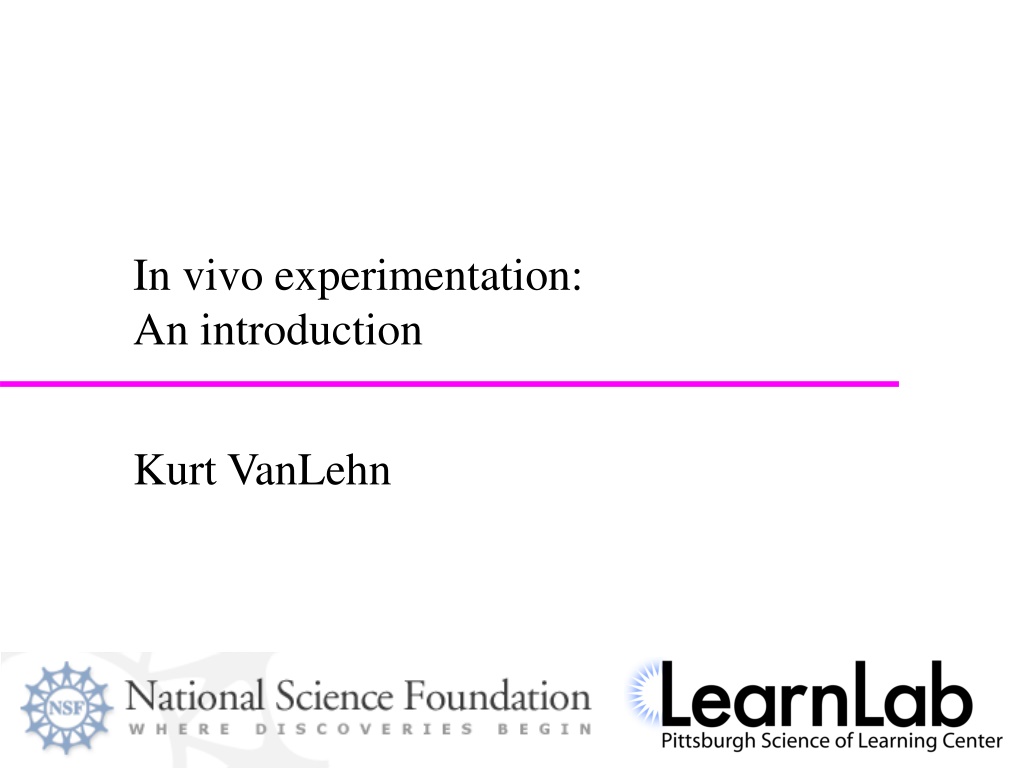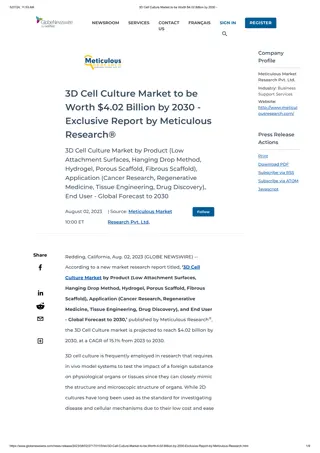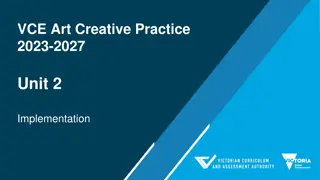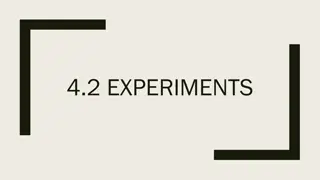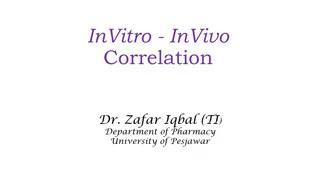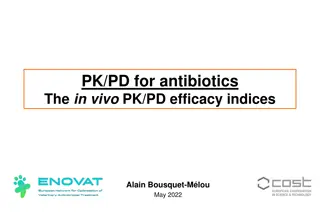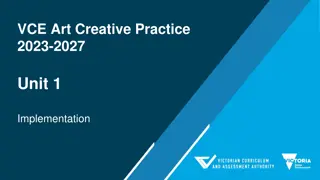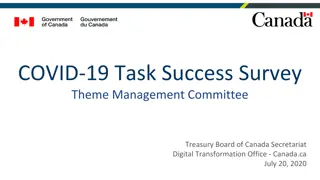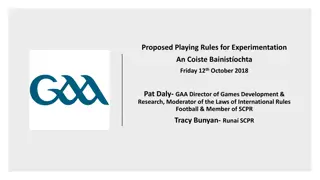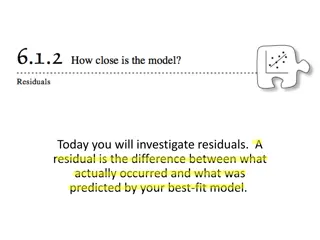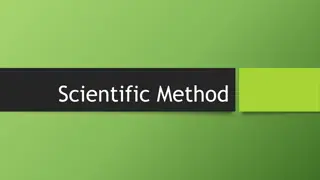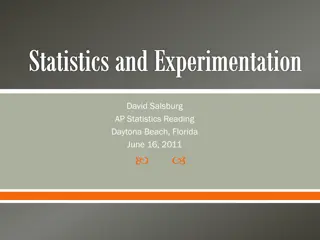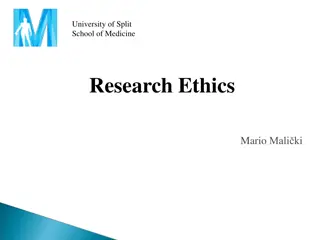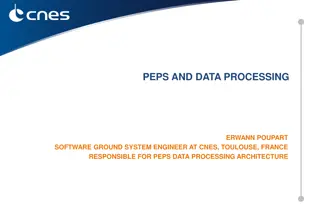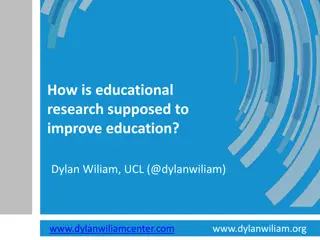Overview of In Vivo Experimentation in Educational Research
This introduction to in vivo experimentation by Kurt VanLehn covers the motivation and definition of in vivo experiments, examples, distinguishing features from other experiments, and popular experimental methods like laboratory and classroom experiments. The content addresses the need for external and internal validity in addressing real instructional problems with authentic students and contexts. It further delves into the goals, participants, contexts, and designs of in vivo experimentation, emphasizing internal and external validity in educational research settings.
- In Vivo Experimentation
- Educational Research
- Internal Validity
- External Validity
- Classroom Experiments
Download Presentation

Please find below an Image/Link to download the presentation.
The content on the website is provided AS IS for your information and personal use only. It may not be sold, licensed, or shared on other websites without obtaining consent from the author. Download presentation by click this link. If you encounter any issues during the download, it is possible that the publisher has removed the file from their server.
E N D
Presentation Transcript
In vivo experimentation: An introduction Kurt VanLehn
Outline In vivo experimentation: Motivation & definition 3 examples Reflection on the 3 examples Distinguishing in vivo from other experiments Quiz & discussion IV track activities for rest of the week
What is the problem? Need external validity Address real instructional problems & content Authentic students (e.g., backgrounds, pretraining) Authentic context (e.g., motivations, social ) Need internal validity Control of variables to avoid confounds E.g., instructor effects
Two most popular experimental methods Laboratory experiments Classroom experiments
Lab experiments Students Volunteers (recruited from classes?) Motivated by money (or credit in psych course) Context Instruction done in a lab (empty classroom?) Experimenter or software does the instruction Maximum of 2 hours per session Typical design Pre-test, instruction, post-test(s) Conditions differ in only 1 variable/factor High internal validity; low external validity
Classroom experiments Participants & context Students from real classes Regular instructors (not experimenter) does teaching Design Train instructors to vary their instruction Observe classes to check that manipulation occurred Assess via embedded pre- and post-test(s), or video High external validity; low internal validity Weak control of variables
In vivo experimentation Goals Internal validity External validity
In vivo experimentation Students and context In a real classroom with real students, teachers Software controls part of instruction In-class and/or homework exercises Records all interactions (= log data) Design Manipulation Software s instruction differs slightly over a long period, or More dramatic difference during one or two lessons Assessment via regular class tests & log data
Outline In vivo experimentation: Motivation & definition 3 examples Reflection on the 3 examples Distinguishing in vivo from other experiments Quiz & discussion IV track activities for rest of the week Next
1stexample: Wang, Lui & Perfettis Chinese tone learning experiment Context CMU Chinese course On-line exercises Given spoken syllable, which tone (of 4) did you hear? Very difficult to learn Hypothesis Earlier work subtle wave form differences exist Does displaying them help?
Chinese tones /ma/ 1: mother /ma/ 2: linen /ma/ 3: horse /ma/ 4: scold Tone number Pinyin
Design Conditions All conditions select tone from menu All conditions given sound + Experiment: wave form & Pinyin Control 1: number & Pinyin Control 2: wave form Procedure Pre-test One exercise session per week for 8 weeks Several post-tests
Preliminary results Error rates during training Experiments < Controls on lessons 2, 5, 6 & 7 Pre/Post test gains Experiments > Control 1 on some measures Control 2 too few participants Tentative conclusion Displaying waveforms increases learning Second semester data being analyzed Other data being analyzed
Why is this an in vivo experiment? External validity Real class, student, teachers Post-tests counted in students grades Cramming? Internal validity Varied only two factors: waveform, Pinyin Collected log data throughout the semester Who actually did the exercises? Error rates, error types, latencies Student profiles
2nd example: Bob Hausmann s first experiment The generation hypothesis: self-explanation > instructional explanation Quick f___ > Quick fast (Slameka & Graf, 1978) The fat man read about the thin ice. (Bransford et al.) How can a worm hide from a bird? (Brown & Kane) The coverage hypothesis: self-explanation = instructional explanation Path-independence (Klahr & Nigam, 2004) Multiple paths to mastery (Nokes & Ohlsson, 2005) Variations on help (Anderson et al., 1995)
Variable q defined for charge Help request buttons Equation: Fe = abs(q)*E Force due to Electric Field Electric Field Immediate Feedback via color Bottom-out hint
Terminology Example = problem + multi-entry solution Complete example = explains every entry Because the force due to an electric field is always parallel to the field, we draw Fe at 17 degrees. It s in this direction because the charge is positive. If it had been negative, it would be in the opposite direction, namely 197 degrees. Incomplete example = no explanations of entries We draw Fe at 17 degrees.
4 conditions Prompted to paraphrase Prompted to self-explain Incomplete Example (each entry presented without explanation) Complete Example (explains each entry)
Predictions Prompted to paraphrase No explanation no learning Instructional explanation ???? Prompted to self-explain Self- explanation learning Self- explanation learning Incomplete Example (each entry presented without explanation) Complete Example (explains each entry) Generation hypothesis: No learning Coverage hypothesis: Learning
Procedure: Each problem serves as a pre-, mid- or post-test Example1 Example2 Example3 Self-explain Complete Self-explain Complete Self-explain Complete Self-explain Incomplete Self-explain Incomplete Self-explain Incomplete Problem1 Problem2 Problem3 Problem4 Paraphrase Complete Paraphrase Complete Paraphrase Complete Paraphrase Incomplete Paraphrase Incomplete Paraphrase Incomplete
In the Physics LearnLab: Spring semester 2006 at the USNA 1. Normal instruction for several weeks Including use of Andes for homework 2. Hausmann s study during a 2-hour physics lab period 3. Normal instruction for several more weeks 4. Craig s study, also during a 2-hour lab period 5. Normal instruction for several more weeks
Dependent measures Log data from problem solving Before, during and after the manipulation Errors Help requests Bottom-out hints Ditto, but main principle only Learning curves Audio recordings of student s explanations Midterm exam 25 students all talking into headset mikes
One measure: Help requests Supports the generation hypothesis: Instructional explanation little learning 50 Number of help requests 40 30 20 10 0 Complete Paraphrase Complete Self- explain Incomplete Paraphrase Incomplete Self-explain
3rd example: Butcher, Aleven et al. geometry study Hypothesis Splitting visual attention harms learning. Geometry Cognitive Tutor: 2 conditions Entries in the diagram: Keeps attention in diagram Entries in a table: Splits attention
Preliminary Results: Transfer Lower Ability Students: Transfer Performance Higher Ability Students: Transfer Performance 40 40 35 35 30 30 Percent Correct Percent Correct 25 25 Table High Diagram High Table Low Diagram Low 20 20 15 15 10 10 5 5 0 0 Pretest Posttest Pretest Posttest Test Time Test Time 3-way interaction: Test Time * Condition * Ability: F (1, 38) = 4.3, p < .05
Outline In vivo experimentation: Motivation & definition 3 examples Reflection on the 3 examples Distinguishing in vivo from other experiments Quiz & discussion IV track activities for rest of the week Next
Methodological variation: Duration of training Wang: Whole semester Hausmann: 2 hour lab session Butcher: 3 week unit on circles
Methodological variation: Condition assignment Wang: Between sections Different sections get different treatments All students in a section assigned to same treatment Hausmann & Butcher: Between subjects Different students assigned to different treatments All sections have all conditions Others: Within subjects Same student gets different treatments at different times All students are in all conditions
Relationship of experimenters software to course s tutoring system Wang s software replaced course s tone-drill software Hausmann Did not develop software Used 4 different video tapes, one per condition Experimental activities replaced a physics lab activity Butcher s software Variation of Carnegie Learning s tutoring system Designed by Butcher et al. Implemented mostly by Carnegie Learning Replaces course s normal software
Outline In vivo experimentation: Motivation & definition 3 examples Reflection on the 3 examples Distinguishing in vivo from other experiments Quiz & discussion IV track activities for rest of the week Next
How does in vivo experimentation differ from course development? Research problem to be solved Primary: An open question in the literature on learning is Secondary: One of the hardest things for students to learn in <class> is Scaling up not necessary One unit of curriculum may suffice Sustainability not necessary OK to use experimenter instead of technology
How does in vivo experimentation differ from lab experimentation? Instructional objectives and content Already taught in course, or Negotiated with instructor Control group must receive good instruction Logistics Timing only one opportunity per semester/year Place Participation not guaranteed Count toward the student s grade?
How does in vivo differ from other classroom experimentation? Superficial differences Treatment implemented by training teachers And observing whether they teach as trained Or better! Can only do between-section, not between-student Control groups are often absent or weak Underlying difference Granularity of the hypotheses and manipulations See next few slides
An example of a large-grained classroom experiment: PUMP/PAT Early version of CL Algebra (Koedinger et al.) Tutoring system (PAT) Curriculum (PUMP) including some teacher training Whole year Hypothesis PUMP/PAT is more effective than conventional instruction
A 2nd example of large grained classroom experiments: CECILE CECILE (Scardamalia, Bereiter et al.) Networked collaborative learning software Long, complex math activities done in small groups Developed and published on the web Whole year Hypothesis CECILE community of learning increases gains
A 3rd example of large grained classroom experiments: Jasper Anchored instruction (Bransford et al.) Jasper video provide a vivid, shared anchor Long, complex math activities tied to anchor Whole year Hypothesis: Anchored instruction prevents inert knowledge
Outline In vivo experimentation: Motivation & definition 3 examples Reflection on the 3 examples Distinguishing in vivo from other experiments Quiz & discussion IV track activities for rest of the week Next
How would you classify this classroom experiment? Reciprocal teaching (Palinscar & Brown) Small, teacher-led groups Students trained two switch roles with teacher & each other Multiple weeks Hypothesis: Reciprocal teaching is more effective than normal small group learning
How would you classify this classroom experiment? Andes tutoring system (VanLehn et al.) Homework exercises done on Andes vs. paper Same exercises, textbook, labs, exams, rubrics Whole semester Hypothesis: Doing homework problems on Andes is more effective than doing them on paper
How would you classify this experiment? (Lui, Perfetti, Mitchell et al.) Normal drill (used as pretraining) Present Chinese character (visual) and pronunciation (sound) Select English translation. Get applauded or corrected Manipulation Select English translation. No feedback. Present character, pronunciation, both or neither Co-training hypothesis Drill with both character and pronunciation > drill with either character or pronunciation (not both) > no extra drill at all Pull out
Should this experiment be redone in vivo? (Min Chi & VanLehn) Design Training on probability then physics During probability only, Half students taught an explicit strategy Half not taught a strategy (normal instruction) Preparation for learning Score Score Ordinary transfer Pre Probability Training Post Pre Post Physics Training
Outline In vivo experimentation: Motivation & definition 3 examples Reflection on the 3 examples Distinguishing in vivo from other experiments Quiz & discussion IV track activities for rest of the week Next
Your job: Simultaneously design 3 elements of an in vivo experiment A hypothesis Fits into literature on learning High information value (in Shannon s sense) A context unit of the curriculum & instructional objective training content and assessments A manipulation Tests the hypothesis Fits well in the context
Schedule Tuesday AM: Become familiar with course & tutoring system Early PM: Become familiar with theory Late PM: Start writing Letter of Intent (2 pgs) State background lit, hypothesis, context, manipulation Wednesday AM Letter of Intent (LOI) due 10:45 am Feedback from course committee representatives Wednesday PM & Thursday Revise design, add details, write proposal & slides Friday Presentation
